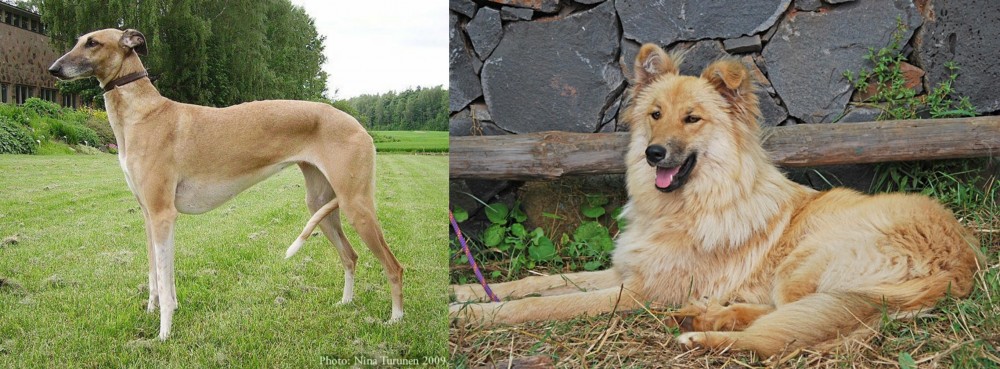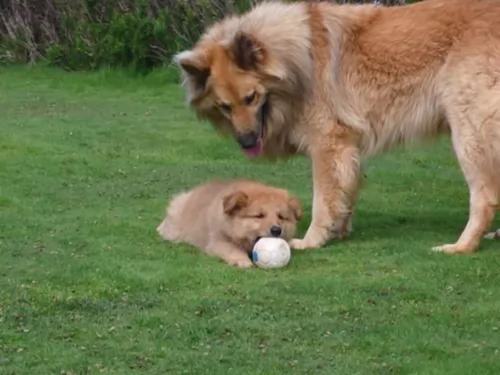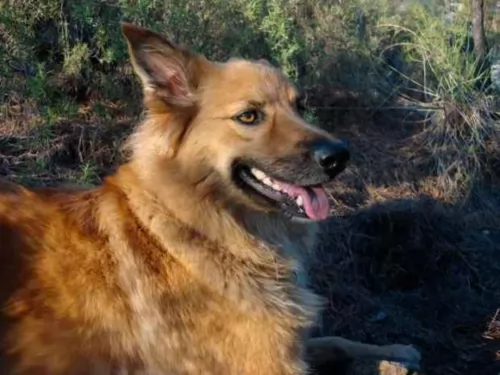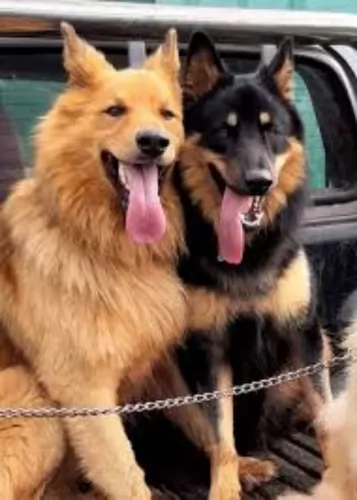 Petzlover
Petzlover Hortaya Borzaya is originated from Russia but Pastor Garafiano is originated from Spain. Hortaya Borzaya may grow 11 cm / 5 inches higher than Pastor Garafiano. Both Hortaya Borzaya and Pastor Garafiano are of same weight. Both Hortaya Borzaya and Pastor Garafiano has almost same life span. Hortaya Borzaya may have less litter size than Pastor Garafiano. Hortaya Borzaya requires Low Maintenance. But Pastor Garafiano requires Moderate Maintenance
Hortaya Borzaya is originated from Russia but Pastor Garafiano is originated from Spain. Hortaya Borzaya may grow 11 cm / 5 inches higher than Pastor Garafiano. Both Hortaya Borzaya and Pastor Garafiano are of same weight. Both Hortaya Borzaya and Pastor Garafiano has almost same life span. Hortaya Borzaya may have less litter size than Pastor Garafiano. Hortaya Borzaya requires Low Maintenance. But Pastor Garafiano requires Moderate Maintenance
 The Hortaya Borzaya is an ancient sighthound from Asia with its origins in Kievan Rus = Grand Duchy of Lithuania = Polish-Lithuanian Commonwealth and the Empire of Russia. The Hortaya is a large dog, especially a long in body dog with a muscular build suitable for running fast. He is one of the most talented of sighthounds, able to track moving prey at quite great distances. He is an intensely active when running prey and quiet and well balanced when not working.
The Hortaya Borzaya is an ancient sighthound from Asia with its origins in Kievan Rus = Grand Duchy of Lithuania = Polish-Lithuanian Commonwealth and the Empire of Russia. The Hortaya is a large dog, especially a long in body dog with a muscular build suitable for running fast. He is one of the most talented of sighthounds, able to track moving prey at quite great distances. He is an intensely active when running prey and quiet and well balanced when not working.
In Asia and Russia, it is still a working hunting dog, hunting a variety of game such as Saiga antelopes, wolves, foxes, and hares. With tremendous endurance, the Hortaya can run at great speeds and great distances on the hunt. The Hortaya Borzaya is a long distance runner rather than a sprinter like the greyhound we are all so familiar with. He also needs very little rest between runs of up to 4 km. The Hortaya uses his sense of smell as well as sight in the hunt. They hunt solo, in pairs or in packs.
It was not until 2004 that the Hortaya was first exported to Europe and given full breeding papers. They went to Germany, Slovakia and the Czech Republic in 2004. They went to Switzerland and Finland in 2005 and to the United States around 2005. Prior to this the Hortaya Borzaya was bred only in its original territory for thousands of years.
Unlike Western breeding programs, the Hortaya is not bred for the purpose of improving the breed. Like Asian thoroughbred horses the breed is considered “finished”. Because of this there was no inbreeding, linebreeding or incest. This is true for about 4-6 generations of a line. This helps the breed to stay healthy.
The breed was developed centuries ago being bred by many different groups of people throughout the region, making it impossible to say exactly where and how this Central Asian/Afghanistan/ southern Russian breed developed. The Russian Kynological Federation (RKF) member of the FCI, developed a standard for the Hortaya Borzaya, which unlike most breed standards, does not tell you what the Hortaya must be like. Instead it tells you what he cannot be.
It gives boundaries that the dog must fit inside in order to be considered a Hortaya Borzaya. This is because the breeds of these dogs in their native territories want to preserve as many different types and sub-types as possible under the banner of one breed. To most people these dogs would look like very different breeds. For this reason, they have not been accepted into International Breed Groups and Associations. The breeders of these dogs do not want to be tied down to one standard. They do not want the breed to be separated into western lines and the original line or show lines and working lines. They wish to keep all the dogs within one grouping.
The breed is recognized on the national level by the originating countries and federations, including Russia’s. There are an estimated 2500-3500 dog of this breed in existence to day. Only a few dozen of the breed exist outside of the original countries. In other Eastern and European countries, the dogs may be registered with hunting associations instead of a breed association.
The breed is held mostly by hunters in remote, local areas and villages that are fairly isolated. Here the Hortaya is seen as a partner in feeding the hunters family and the dog is invaluable. In these remote areas a good hunting dog is equal in value to the good horse. Both are essential to the hunter and his family’s livelihood.
The Hortaya Borzaya is a pack dog and does well with the family as well as an athletic hunter. They hunt in packs, small groups or alone and bring their catch back to the hunter for the family meal. No hunter had to go with the dog. In fact, the hunters would send the dogs several times for food. The Hortaya might travel for miles across tough terrain to get food for the family.
 Hailing from the Canary Islands, the Pastor Garafiano is a dog which was once used for working purposes but which is essentially a pet today.
Hailing from the Canary Islands, the Pastor Garafiano is a dog which was once used for working purposes but which is essentially a pet today.
Also known as the Spanish Collie, it is not really sure if the dog really has any links to the Collie.There are dog experts who claim that there are actually very few pure specimens of this dog because of interbreeding with other breeds such as the German Shepherd.
There was a time that the breed almost disappeared but a working group was established to further establish breeding centers for the dog. Today the Pastor Garafiano is a recognized breed and he has been registered since 1982.
 This athletic sighthound is a handsome dog, ranging from large to giant. Remember there are many different ‘types’ of dogs within the one line/breed of Hortaya. Breed standards are exclusionary, and performance based rather than inclusionary, and appearance based. Still most of the breed lines share many of the same traits.
This athletic sighthound is a handsome dog, ranging from large to giant. Remember there are many different ‘types’ of dogs within the one line/breed of Hortaya. Breed standards are exclusionary, and performance based rather than inclusionary, and appearance based. Still most of the breed lines share many of the same traits.
They are a long legged breed with a very deep chest and flexible spine. They have immensely strong lungs and a narrow but long skull. Their gait is fluid, effortless trotting when not hunting. When she is hunting, they gallop like a horse and cover a lot of ground.
There eyes are usually black but can be any color and their fur is also any color. It is thick and dense. Finally, in the 2000’s, there were some dogs in a subline exported to Europe and to North America. Here, for this subgroup, a standard was established based on appearance and the color or the coat was now set at only white, blue, black, cream, red, sable and brindle, and piebald. They might or might not have a saddle. Definition of this type is still going on and has not been entirely settled yet. This standard is only for the European and American market show dogs.
These dogs, bred for show, have the same ability to run like the wind and for a very long time with his muscled body and long legs. The breed has strength and stamina that will fool you. He also has a long neck and broad back. He has thin, short ears.
 This is a medium to large dog, with its hindquarters being a bit higher than the shoulders. The body is strongly built with a deep chest. He stands at between 55 to 64cm in height and weighs between 24 to 35kg.
This is a medium to large dog, with its hindquarters being a bit higher than the shoulders. The body is strongly built with a deep chest. He stands at between 55 to 64cm in height and weighs between 24 to 35kg.
The nose is black and the eyes brown. The ears are slightly erect. The double coat is long and thick and the color is almost golden or tawny, much like a lion. Puppies are born brown and the color changes as they get older.
The tail is long, and when the dog is in motion or alert the tail is lightly curled. He is an active dog requiring a lot of intensive physical exercise. It is therefore not recommended that he be kept on a small city property but that he be on a farm or have a large garden.
This is a good looking, confident sheepdog who is also intelligent and therefore easily trained. He makes a splendidly obedient pet when he has been trained and socialized.
He is docile, calm and friendly and good with children in the home who have been taught to be kind and gentle with him. Apart from regular play, make sure he gets his regular exercise and he is constantly allowed to be part of the family.
 Children friendliness - yes, they are very good with children and will play with them for hours.
Children friendliness - yes, they are very good with children and will play with them for hours.
They have tremendous stamina, speed and intelligence to hunt on their own without the hunter and bring the prey back in good shape for the hunter’s family to eat.
No they are not very adaptable in terms of living arrangements. They will not do well in an apartment and probably not in the city as they need land to run.
Learning ability yes, they are intelligent and learn easily.
 The Pastor Garafiano is such a wonderful docile and friendly pet that he is guaranteed to make a wonderful companion for any family.
The Pastor Garafiano is such a wonderful docile and friendly pet that he is guaranteed to make a wonderful companion for any family.
He is a dog that simply loves spending time with his human family and won’t do well when left alone in the backyard day after day. Take good care of this beautiful tawny dog and give him your attention and you will have a wonderful canine friend that is difficult to beat in terms of loyalty and devotion.
 As previously mentioned, the original breed is isolated and therefore has a pretty good health track record. Most of the breed specific illnesses or conditions that usually are inherited barely exist in this breed.
As previously mentioned, the original breed is isolated and therefore has a pretty good health track record. Most of the breed specific illnesses or conditions that usually are inherited barely exist in this breed.
They have a propensity toward obesity and diet is essential to prevent other issues.
Chronic or acute pancreatitis is possible because the breed developed eating small meals and hardly any meat. Too much meat or fat could cause this.
No tolerance for high protein dog food. Can cause puppies to have life threatening damage to bones and cartilage that is irreversible.
Bloat – because of the deep chest and the intolerance for large meals they are prone to bloat.
 Your Pastor Garafiano can reach anything from 10 – 14 years of age if he is happy and well taken care of. Every dog however, can fall prey to one of the many common dog illnesses there are. Some of these are -
Your Pastor Garafiano can reach anything from 10 – 14 years of age if he is happy and well taken care of. Every dog however, can fall prey to one of the many common dog illnesses there are. Some of these are -
This is an inherited inflammatory disease of the skin, blood vessels and muscles. Signs of dermatomyositis can vary from mild to severe skin lesions and inflammation of muscles and even a decrease in muscle mass. Severely affected dogs can even have difficulty with swallowing. Symptoms of the disease are usually seen before the dog is 6 months of age.
This is an eye disease where there is a gradual deterioration of the retina. Dogs can become night blind early in the disease and as the disease goes on, they can even lose their daytime vision.
This is a very common dog ailment – the abnormal formation of the hip socket can cause pain, arthritis and even lameness. It is severe enough to know that dogs with hip dysplasia should never be bred.
 As mentioned above do not overfeed a Hortaya Borzaya puppy. There is serious risk of irreversible damage if you do. Feed small meals 3-6 times a day with lower protein.
As mentioned above do not overfeed a Hortaya Borzaya puppy. There is serious risk of irreversible damage if you do. Feed small meals 3-6 times a day with lower protein.
3 cups of an average protein high quality dog food served at least 3-4 times per day. To avoid bloat do not feed large meals before or after exercise and don’t let your dog drink a lot of water at one time.
This is an extremely active dog bred to hunt 5-6 times a day over wide expanses of various and rough terrain. They need exercise. If you run, they will run with you happily and they will outlast you. They are good at and enjoy fetch, chase, agility, and field trials. They will last hours at any game they play.
 Groom your Pastor Garafiano at least twice a week. Your dog’s coat is fairly long and it sheds too and you want to make sure it doesn't become all matted. There are different brushes you can use for his beautiful coat.
Groom your Pastor Garafiano at least twice a week. Your dog’s coat is fairly long and it sheds too and you want to make sure it doesn't become all matted. There are different brushes you can use for his beautiful coat.
You can also use this grooming session to check other areas of your dog. Check inside his ears, check his eyes and feel for new or unusual lumps. Make sure to keep his nails trimmed.
Exercise your pet every day. Take him on walks or hikes and provide him with ball or frisbee games. Exercise keeps him fit and healthy but also happy and content.
Nutrition is of critical importance to your pet's wellbeing. It is important to know what your pet needs to stay healthy and have a strong immune system which can ward off disease.
There are some good commercially manufactured dog foods on the market but it is important to choose the one that doesn’t come filled with toxic colorants, preservatives and fillers. Protein should be high on the list of ingredients listed on the pet food packaging. Also make sure to feed your pet food that had been made for his size, his breed, his age and his energy requirements.
To provide some variety to your pet’s diet, give him some tasty home-made food. Dog’s do well on simplicity and consistency. Some boiled chicken, brown rice or pasta and some cooked vegetables such as spinach, sweet potato and carrots all chopped up and added into his dry kibble occasionally will keep him bright eyed and with his tail constantly wagging.
He’ll thank you for not varying his diet with things that can give him an upset stomach such as coffee, tea, popcorn, grapes, onions and chocolate.